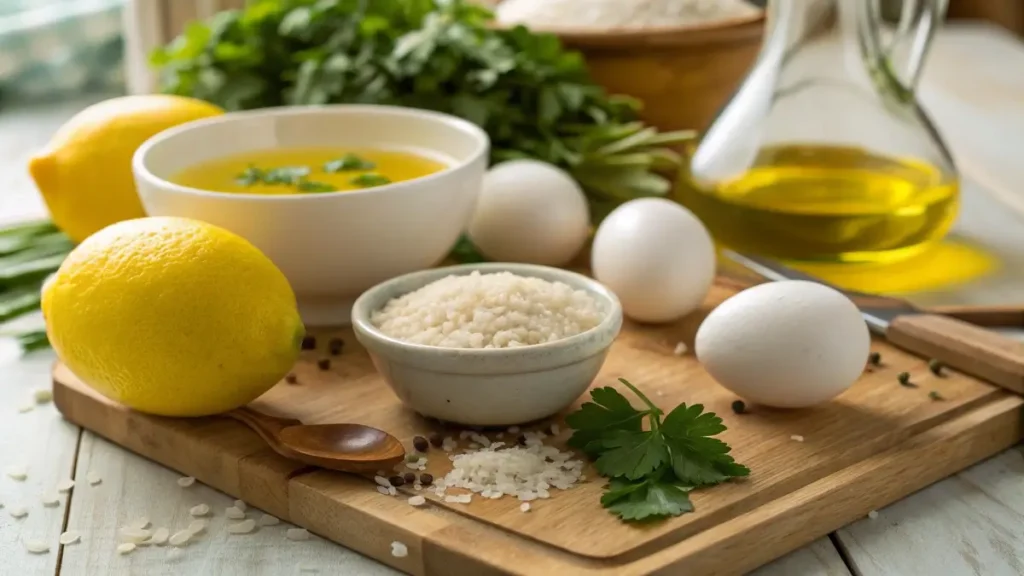Authentic Greek Lemon Rice Soup Recipe – A Complete Guide
Greek lemon rice soup, commonly known as Avgolemono, is one of Greece’s most cherished comfort foods. This creamy, tangy, and heartwarming dish blends simple ingredients like rice, eggs, lemon juice, and broth into a bowl of pure joy. In this guide, we’ll cover everything you need to know to make the perfect Greek lemon rice soup recipe at home. From its rich history and cultural importance to step-by-step cooking methods, this article ensures you master this traditional dish like a pro.
Table of Contents
Introduction to Greek Lemon Rice Soup Recipe
The origins and cultural significance of Greek lemon rice soup
The Greek lemon rice soup recipe, or Avgolemono, has been passed down through generations in Greece. Its roots go back to ancient times, when Greeks embraced lemon for both culinary and medicinal purposes. Traditionally served at family gatherings, festive holidays, and even as a healing dish during colds, this soup symbolizes warmth, care, and home-cooked love. The combination of rice, egg, and lemon creates a dish that’s as soothing as it is flavorful. In many Greek homes, no celebration is complete without a steaming pot of Avgolemono on the table.
Why this soup is a staple in Greek households
You’ll find Greek lemon rice soup recipe variations in almost every Greek kitchen. Why is it so popular? Its magic lies in its versatility. This soup can be served as a starter or as a main course, depending on how hearty you make it. It’s budget-friendly, quick to prepare, and uses pantry staples that are always on hand. More importantly, it brings families together. Every spoonful tells a story of Greek tradition, resilience, and hospitality.
What Is Greek Lemon Rice Soup Called?
The meaning and pronunciation of “Avgolemono”
The beloved Greek lemon rice soup recipe is famously known as Avgolemono (pronounced ahv-go-LEH-mono). The name comes from two Greek words: avgo meaning egg, and lemono meaning lemon. True to its name, the soup is characterized by a delicate balance of beaten eggs and fresh lemon juice, creating a rich, velvety texture and bright, zesty flavor. The term Avgolemono doesn’t just apply to soup; it also refers to a sauce made with the same egg-lemon mixture, often drizzled over meat, fish, or vegetables.
What makes Avgolemono unique compared to other rice soups is how the eggs are tempered and blended, transforming a simple broth into something creamy without adding any cream. This cooking method is a testament to the resourcefulness and culinary genius of traditional Greek cooking.
Historical background of Avgolemono soup in Greek cuisine
The Greek lemon rice soup recipe has deep historical roots. Some food historians trace the origins of Avgolemono to Sephardic Jewish communities, where a similar egg-lemon sauce was popular before it spread through the Mediterranean, including Greece. Over centuries, Greeks embraced and refined this recipe, making it their own by pairing it with rice or orzo and chicken or lamb broth. The soup became a household favorite, not only for its comforting taste but also because it stretches simple ingredients into a satisfying meal.
Today, Avgolemono is more than just food—it’s a dish served at celebrations, on cold winter nights, and as a traditional remedy during illness. This timeless recipe reflects the heart of Greek culinary traditions, blending simplicity with bold flavors.
Ingredients for the Best Greek Lemon Rice Soup

Traditional ingredients list for authentic flavor
When preparing an authentic Greek lemon rice soup recipe, sticking to the classic ingredients is key to achieving that signature creamy, tangy, and comforting taste. Below is the traditional lineup you’ll find in Greek kitchens:
| Ingredient | Quantity | Notes |
|---|---|---|
| Chicken broth or stock | 6 cups | Homemade or low-sodium preferred for depth of flavor |
| Rice (short-grain or medium-grain) | 1/2 cup | Adds the perfect creaminess |
| Eggs | 3 large | Forms the base of the Avgolemono |
| Fresh lemon juice | 1/4 cup (or to taste) | For that essential citrusy tang |
| Olive oil | 2 tablespoons | Adds richness |
| Salt | To taste | Enhances the flavors |
| Black pepper | To taste | Optional, for a slight kick |
| Fresh parsley (optional) | For garnish | Adds a pop of color and freshness |
Each ingredient serves a purpose. The rice thickens the broth naturally. The egg and lemon mixture creates the creamy texture and zesty flavor that defines this soup.
Substitutions and variations for modern tastes
If you want to adapt the Greek lemon rice soup recipe for dietary preferences or simply to shake things up, there are many delicious substitutions:
- Broth: Vegetable broth works beautifully for a vegetarian version.
- Rice: You can use orzo pasta or even quinoa if you prefer.
- Eggs: To reduce cholesterol, try using two whole eggs and two additional egg whites.
- Lemon: Love it extra tangy? Add a bit of lemon zest along with the juice.
- Add-ins: Shredded cooked chicken, spinach, or chickpeas can transform this soup into a heartier meal.
These modern tweaks let you enjoy Avgolemono while tailoring it to your dietary needs and flavor preferences.
What Kind of Rice Is Used in Avgolemono?
The preferred rice types for Greek lemon rice soup
When it comes to nailing an authentic Greek lemon rice soup recipe, the type of rice you choose makes all the difference in texture and taste. Traditionally, Greeks opt for short-grain or medium-grain white rice. Why? Because these varieties release just enough starch during cooking to naturally thicken the broth and give the soup that silky, creamy consistency without needing cream or flour.
Here’s a quick guide to the most popular rice choices for Avgolemono:
| Rice Type | Texture Result | Notes |
|---|---|---|
| Short-grain white rice | Creamy and thick | Ideal for classic Avgolemono |
| Medium-grain rice | Slightly less creamy but still smooth | Great alternative |
| Arborio rice | Very creamy, risotto-style finish | Can be used if short-grain isn’t available |
| Long-grain rice | Thinner, less starchy | Not traditional, but fine in a pinch |
Choosing the right rice is key to getting that comforting, rich mouthfeel that makes Avgolemono so beloved.
How rice texture affects the soup’s consistency
Rice isn’t just filler in the Greek lemon rice soup recipe—it plays a starring role in creating the soup’s signature creamy body. The starch from the rice subtly blends into the broth as it simmers, working together with the egg-lemon mixture to form a velvety, cohesive soup.
If you use long-grain rice, which is less starchy, you may find the soup feels thinner or less luxurious. On the flip side, using a high-starch rice like Arborio can give the soup a slightly risotto-like thickness, which some folks actually love. For best results, stick to what Greek grandmothers use: short- or medium-grain rice. This ensures the soup’s consistency is just right—smooth, satisfying, and perfect for cradling in a bowl on a chilly day.
How Is Greek Lemon Rice Soup Made?
Step-by-step method for making Avgolemono soup
Making an authentic Greek lemon rice soup recipe isn’t difficult, but it does require a little care—especially when it’s time to add the eggs and lemon. Follow this tried-and-true method for a foolproof Avgolemono:
- Prepare the broth: In a large pot, bring chicken or vegetable broth to a gentle boil. Stir in olive oil and season with salt and pepper.
- Cook the rice: Add short- or medium-grain rice directly to the simmering broth. Reduce heat and cook uncovered until rice is tender, about 15-20 minutes.
- Make the Avgolemono mixture: In a bowl, beat the eggs until frothy. Gradually whisk in the fresh lemon juice.
- Temper the eggs: Very slowly ladle hot broth into the egg-lemon mixture, whisking constantly. This step is crucial to prevent curdling.
- Finish the soup: Once the egg mixture is warmed, gently stir it back into the pot. Simmer over very low heat (do not boil) for 2-3 minutes, until the soup thickens slightly.
- Serve: Ladle into bowls and garnish with fresh parsley if desired.
By following these steps, you’ll create a velvety, lemony soup that’s full of traditional Greek flavor.

Cooking tips for achieving a creamy and smooth finish
Tempering the egg-lemon mixture is the heart of any Greek lemon rice soup recipe. Get this right, and your soup will have a beautiful creamy texture without any curdling. Here are some pro tips:
- Go slow: Add the hot broth to the eggs gradually. Rushing this step is the fastest way to scramble the eggs.
- Keep the heat low: Once you add the tempered mixture to the soup, keep the heat at a gentle simmer—never let it boil.
- Use fresh lemon juice: Bottled lemon juice can’t match the bright, fresh flavor of a real lemon.
- Adjust thickness: If the soup is too thick, stir in a little extra broth until it reaches your desired consistency.
Do You Cook Rice Before Adding to Soup?
The role of rice pre-cooking in the recipe
One of the most common questions when following a Greek lemon rice soup recipe is: Do I cook the rice before adding it to the soup? The traditional answer is no. In authentic Avgolemono, rice is usually cooked directly in the broth.
Why is that? Cooking the rice in the broth allows the natural starches from the rice to release into the liquid. This helps create the soup’s signature creamy texture without the need for added cream or thickening agents. It also means the rice soaks up the flavor of the broth as it cooks, adding richness and depth to every spoonful.
Here’s a quick comparison:
| Method | Pros | Cons |
|---|---|---|
| Cook rice in broth | Creamier texture, richer flavor | Slightly longer cook time |
| Pre-cook rice separately | Faster final assembly, more control over rice doneness | Less creamy soup, fewer flavors absorbed by rice |
So, for that true Greek feel, let your rice cook right in the broth.
Pros and cons of cooking rice separately vs. in the soup
Some modern cooks prefer to cook rice separately when making Greek lemon rice soup recipe, especially if they’re short on time or want to avoid overcooked grains. While this can speed things up, it does change the final dish in subtle ways:
- Cooking rice separately: This gives you perfect control over the rice’s texture. It’s a good option if you’re preparing the soup ahead of time and want to avoid mushy rice on reheating. However, you’ll miss out on the natural thickening that happens when rice cooks in the broth.
- Cooking rice in the broth: This is the traditional method and produces a more unified, creamy soup where the flavors marry beautifully. The rice releases starches into the liquid, contributing to the soup’s velvety body.
Ultimately, both methods work, but if you want the full Greek experience, let the rice cook in the broth.
Variations of Greek Chicken Soup with Rice and Lemon
How to add chicken to your Avgolemono
While the classic Greek lemon rice soup recipe is delicious on its own, many home cooks like to turn it into a heartier dish by adding chicken. This variation transforms Avgolemono from a light starter to a satisfying main course.
Here’s how to incorporate chicken seamlessly:
- Use bone-in chicken for the broth: Simmer bone-in, skin-on chicken (such as thighs or a whole chicken) in water with aromatics like onion, garlic, and bay leaf to create a rich, homemade broth. Once cooked, shred the chicken and return it to the pot.
- Shortcut version: If you’re short on time, rotisserie chicken or leftover roasted chicken works wonderfully. Simply shred the meat and stir it into the finished soup.
- Timing: Add the shredded chicken during the final few minutes of cooking so it warms through without becoming overcooked.
Chicken not only adds protein but also enhances the flavor, making the soup more filling.
Popular regional and family variations of the soup
Across Greece, families put their own spin on the Greek lemon rice soup recipe, reflecting local ingredients and traditions. Some of the most common variations include:
- Avgolemono with orzo: In place of rice, orzo pasta is used, giving the soup a slightly different texture but the same creamy, lemony taste.
- Avgolemono with lamb broth: In certain regions, especially in the countryside, lamb broth replaces chicken broth for a deeper, more robust flavor.
- Vegetarian Avgolemono: Made with vegetable broth and sometimes featuring greens like spinach or kale for added nutrition.
- Thicker versions: Some families add more rice or even a bit of flour to make the soup almost stew-like in consistency.
These variations show how versatile Avgolemono is and how it adapts to different tastes and ingredients.
Common Mistakes to Avoid When Making Lemon Rice Soup
Preventing curdling when adding eggs and lemon
One of the trickiest parts of preparing an authentic Greek lemon rice soup recipe is tempering the egg-lemon mixture. Curdling happens when the eggs cook too fast and form lumps rather than blending smoothly into the broth. Here’s how to avoid it:
- Always temper the eggs slowly. Whisk hot broth gradually into the egg-lemon mixture while constantly stirring. This warms the eggs gently so they don’t scramble.
- Don’t let the soup boil after adding the egg mixture. Once the Avgolemono is in, keep the heat at a very low simmer. Boiling will cause the eggs to seize up and curdle.
- Whisk well and continuously. Consistent whisking during tempering and while adding the mixture back to the soup ensures a smooth, creamy finish.
Remember, patience is key. This step defines the silkiness of your Avgolemono.
Balancing the flavors: acid, salt, and richness
Another common pitfall when making a Greek lemon rice soup recipe is not balancing the flavors correctly. Avgolemono is all about harmony between the tartness of the lemon, the richness of the broth and egg, and the seasoning. Here’s how to nail that balance:
- Taste as you go. After adding the lemon juice, take a moment to taste. Adjust with more salt, lemon, or pepper if needed.
- Don’t overdo the lemon. While the bright, tangy lemon flavor is essential, too much can overpower the delicate creaminess of the soup.
- Season the broth properly before adding the egg-lemon mixture. Once the mixture is in, it’s harder to correct seasoning without risking curdling.
A well-balanced Avgolemono should be velvety, with a gentle lemony brightness and just the right touch of salt.
Serving Suggestions and Storage Tips

What to serve with Greek lemon rice soup
A steaming bowl of Greek lemon rice soup recipe is satisfying on its own, but pairing it with the right sides can turn it into a complete, memorable meal. Here are some classic and creative ideas:
- Crusty bread or pita: Perfect for soaking up the creamy broth.
- Greek salad: The fresh, crisp vegetables and briny feta contrast beautifully with the soup’s richness.
- Grilled vegetables: Lightly charred zucchini, eggplant, or bell peppers add depth to your meal.
- Olives and cheese platter: For a true Greek feast, serve Avgolemono alongside Kalamata olives and chunks of feta or kasseri cheese.
- Spanakopita or tiropita: These savory pastries are traditional companions to Greek soups.
Serving tip: Avgolemono shines when served hot, in a warm bowl, with a sprinkle of fresh herbs on top.
How to store and reheat for the best taste
If you have leftovers, storing your Greek lemon rice soup recipe properly ensures it stays delicious. Here’s what you need to know:
- Refrigeration: Cool the soup to room temperature, then transfer to an airtight container. It will keep in the fridge for up to 3 days.
- Reheating: Warm gently over low heat, stirring often. Do not let it boil, or the egg-lemon mixture may curdle.
- Freezing: While possible, freezing isn’t ideal as it can change the texture of the egg mixture and rice. If you do freeze it, thaw slowly in the fridge and reheat carefully.
Pro tip: If you anticipate storing leftovers, consider cooking the rice separately and adding it fresh to each bowl when serving. This prevents the rice from becoming mushy.
Conclusion
The Greek lemon rice soup recipe is more than just a dish—it’s a taste of Greece’s culinary soul. With its comforting texture, vibrant lemon flavor, and rich heritage, Avgolemono continues to warm hearts and bellies around the world. Whether you stick to tradition or try one of the delicious variations we’ve shared, mastering this recipe is sure to bring a little bit of Greece to your kitchen.
FAQs
What is Greek lemon rice soup called?
Greek lemon rice soup is called Avgolemono. The name comes from the Greek words avgo (egg) and lemono (lemon), describing the two signature ingredients that give this soup its creamy texture and bright, tangy flavor. This dish is a beloved staple in Greek cuisine, often served during family gatherings and festive occasions.
What is Greek chicken soup with rice and lemon?
Greek chicken soup with rice and lemon is a variation of Avgolemono where shredded chicken is added to the classic Greek lemon rice soup recipe. The chicken adds protein and richness, transforming the dish into a satisfying main course. Typically, the chicken is simmered to create a flavorful broth, then combined with rice and the egg-lemon mixture.
What kind of rice is used in avgolemono?
The best rice for an authentic Greek lemon rice soup recipe is short-grain or medium-grain white rice. These types of rice release just enough starch to naturally thicken the soup and contribute to its signature creamy consistency. While orzo or Arborio rice can also be used, short-grain rice remains the traditional choice.
How is lemon rice soup made?
Lemon rice soup, or Avgolemono, is made by simmering rice in a rich chicken or vegetable broth. A mixture of eggs and fresh lemon juice is tempered with hot broth, then gently stirred back into the soup. This creates a creamy, smooth texture without any added cream. The soup is finished with seasoning and fresh herbs.
Do you cook rice before adding to soup?
In a classic Greek lemon rice soup recipe, the rice is usually cooked directly in the broth. This allows the rice to absorb the broth’s flavor and release starches that help thicken the soup naturally. However, some variations call for pre-cooked rice, especially when preparing the soup ahead of time.
What are the ingredients of lemon rice?
For Avgolemono, or lemon rice soup, the key ingredients include chicken or vegetable broth, short- or medium-grain rice, eggs, fresh lemon juice, olive oil, salt, pepper, and optionally, fresh herbs like parsley. Each ingredient plays a vital role in creating the soup’s unique balance of creamy richness and zesty brightness.

